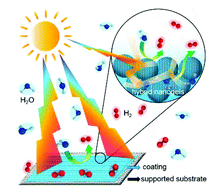A hydrogen evolution system based on hybrid nanogel films with capabilities of spontaneous moisture collection and high light harvesting†
Abstract
A novel hydrogen evolution system based on hybrid nanogel films was successfully prepared with capabilities of spontaneous moisture collection and high light harvesting. Hybrid nanogels were synthesized by homogeneously dispersing graphitic carbon nitride with Pt atom (g-C3N4/Pt) loaded nanosheets into poly(di(ethyleneglycol) methylether methacrylate-co-poly(ethylene glycol) methylethermethacrylate) nanogels. Compared to pure g-C3N4/Pt nanosheets, aggregation and precipitation are prevented in the hybrid nanogels. Because of the large specific area of the hybrid nanogels (500 nm), spontaneous collection of moisture is realized when exposed to different relative humidities. Compared to bulk hydrogels, the moisture absorption capability of the hybrid nanogel films is dramatically increased especially at low relative humidity. Moreover, due to the multiple scattering of visible light and self-supply of water in the hybrid nanogels, the hydrogen evolution of the swollen hybrid nanogel film (thickness of 1 mm) significantly rises to 4994 μmol h−1 g−1 even in a non-aqueous environment (N2 atmosphere), which is almost three times (273%) that of pure g-C3N4/Pt powder in water. Thus, the obtained hybrid nanogel films can realize cyclic water collection and hydrogen production in a single system. No additional refilling of water is required for the present system.



 Please wait while we load your content...
Please wait while we load your content...